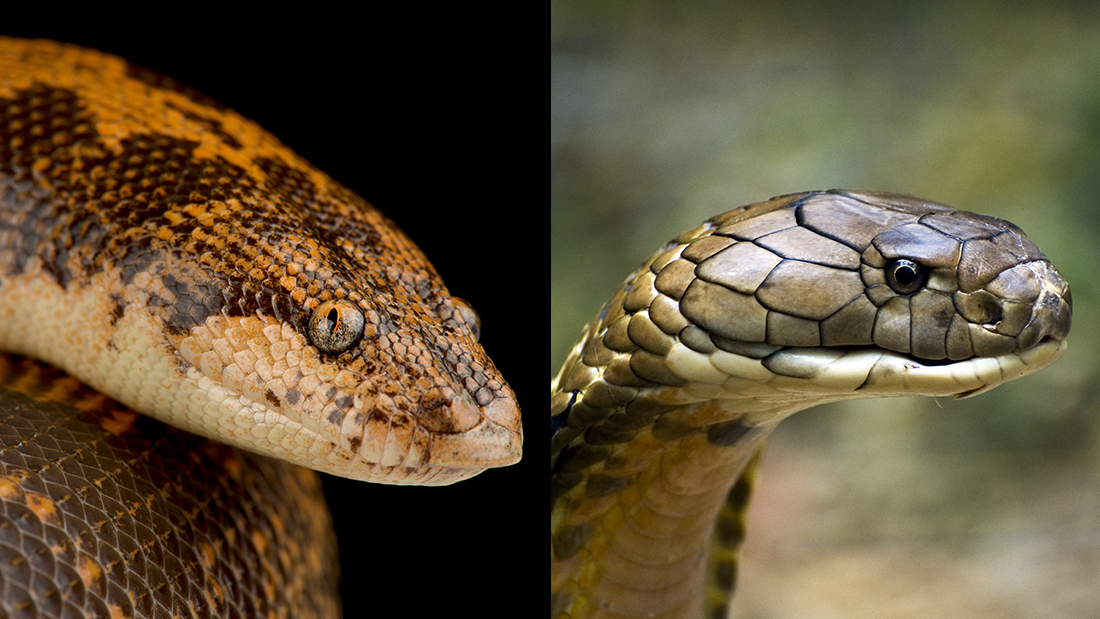Animal intelligence is a complex and hotly debated topic; there’s even some debate about the sentience of certain species and their ability to think. However, that hasn’t stopped us from giving bees math problems and marveling at falcons’ ability to solve puzzle boxes. But where do snakes fit into this spectrum of animal intelligence?
ADVERTISEMENT GO AD FREE
Snakes are one of the most prolific and ancient reptile groups, despite being cold-blooded, they are able to thrive in every content except Antarctica. With the oldest known snake fossil dating back roughly 143 and 167 million years, these reptiles have existed on both land and sea for far longer than any human ancestor, so if you want to consider intelligence in relation to prevalence, perseverance, and longevity, snakes are up there with the best.
However, if it’s more traditional processing skills you’re after, the King cobra is widely regarded as the thinker of the snake world.
While King cobras of the genus Ophiophagus, derived from the Greek meaning “snake-eater”, were previously thought to be just one species (Ophiophagus hannah), it has now been discovered that there are, in fact, four distinct species of King cobra – none of which are actually true cobras as they are not part of the Naja genus.
Reaching 5.6 meters (19 feet) in length, King cobras are the longest venomous snake species and are found across most of Asia, from India and China to the Philippines and the Sunda Islands. Highly venomous, King cobras produce neurotoxic venom that paralyzes the nervous system – one bite from these brainy noodles is enough to kill one adult elephant or 20 people.
Despite having the ability to lift one-third of their body off the ground and look a grown person in the eye, King cobras, like most snake species, are notoriously shy, cautious, and surprisingly intelligent.
As active hunters, King cobras utilize their big brains to strategically stalk their prey, which can include other venomous snakes. While there is little formal research into their intelligence, anecdotal evidence suggests King cobras are able to remember their surroundings, their keepers (if kept in captivity), and even simple tasks like those used to carry out medical examinations.
ADVERTISEMENT GO AD FREE
King cobras are also the only snake species known to build nests for their young, forming a mound out of surrounding leaves and vegetation. However, while their strategic hunting style and nest building are pretty unique for snake species, their ability to memorize people, places, and routines is relatively common in snakes.
Active hunter species, many of which fall into the same family as King cobras (Elapidae), generally show similar levels of intelligence when it comes to hunting prey. Their more docile ambush hunter counterparts, however, make up for their lack of hunting smarts by being well-attuned to environmental changes and routines.
A common technique among snake keepers is “tap training” – a method that involves lightly tapping the enclosure to teach the snake when to expect food – which most snakes are able to learn fairly quickly. Anyone who has kept or spent time with most snake species will know that they are able to recognize people, places, and routines just as well as any King cobra.

A Kenyan sand boa (left) with visibly fewer brain cells than a King cobra (right).
Image credit: reptiles4all / Heiko Kiera / Shutterstock.com
However, much of the anecdotal evidence of King cobra intelligence is just based on vibes – they look smart, and they look like they have a brain behind their eyes – something that definitely cannot be said for all snake species.
Source Link: What Is The Most Intelligent Snake Species?